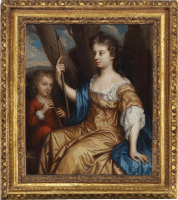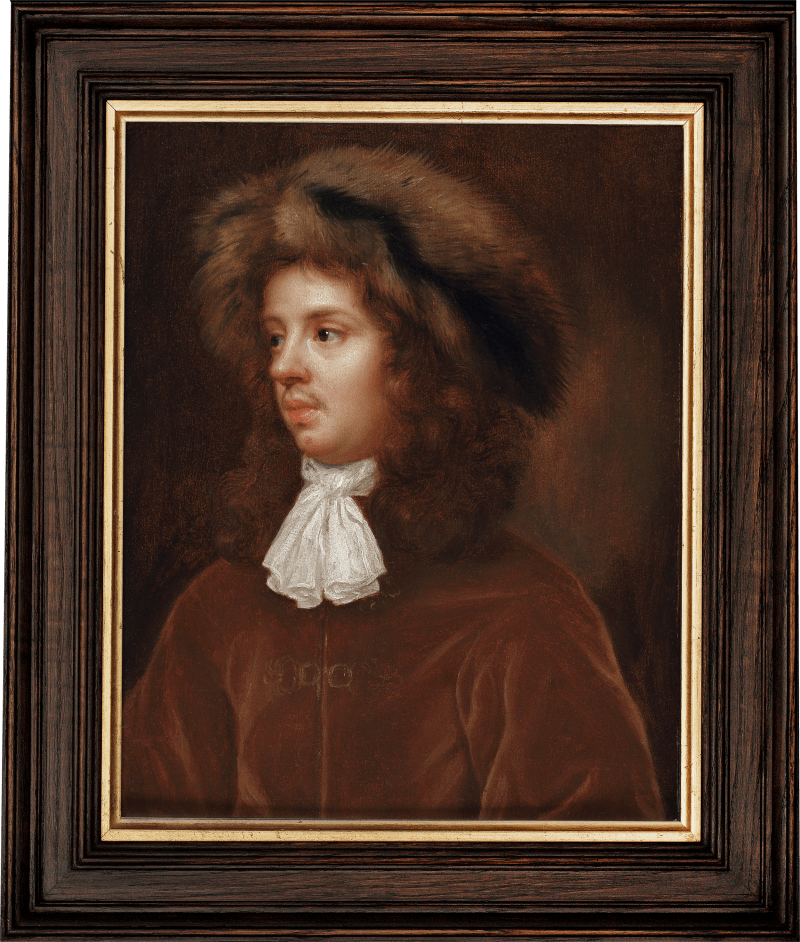This is considered a self-portrait of the artist with her son. Gazing into the distance, the sitter is depicted in a pastoral landscape in the guise of a shepherdess; she is dressed in classical drapery with her arm wrapped elegantly around her crook. The young flute player is dressed in similar costume to the boy in Beale’s The Young Bacchus (fig. 36), which has been tentatively suggested to depict either Charles or Bartholomew, although no firm identification has been ascribed. [1] It is more likely to depict Bartholomew, whose portrait Beale painted repeatedly in around twelve surviving head studies. Given the age of the child, the portrait would have been painted around a similar date to her Self-Portrait, c. 1666.
The compositional similarities between this portrait and a known type by Sir Peter Lely are notable (fig. 37). Later in her career, Beale produced many ‘in little’ portraits after full-scale works by Lely, and she also implemented poses...
This is considered a self-portrait of the artist with her son. Gazing into the distance, the sitter is depicted in a pastoral landscape in the guise of a shepherdess; she is dressed in classical drapery with her arm wrapped elegantly around her crook. The young flute player is dressed in similar costume to the boy in Beale’s The Young Bacchus (fig. 36), which has been tentatively suggested to depict either Charles or Bartholomew, although no firm identification has been ascribed. [1] It is more likely to depict Bartholomew, whose portrait Beale painted repeatedly in around twelve surviving head studies. Given the age of the child, the portrait would have been painted around a similar date to her Self-Portrait, c. 1666.
The compositional similarities between this portrait and a known type by Sir Peter Lely are notable (fig. 37). Later in her career, Beale produced many ‘in little’ portraits after full-scale works by Lely, and she also implemented poses from his paintings within her own portraits. This is the only known example of the artist presenting herself in a Lely posture. Here, Beale’s variation on Lely’s type subtly aligns her with Lely’s female sitters: genteel, respected and fashionable. Portraiture tropes at this date followed highly gendered conventions, and the Arcadian shepherdess guise was considered ‘feminine’ and ‘graceful’. The iconography was powerful. Van Dyck had portrayed the courtiers of Charles I in this arcadian guise, just as Lely portrayed King Charles II’s mistresses as shepherdesses, including numerous depictions of Barbara Palmer, 1st Duchess of Cleveland (1640-1709) and Louise de Kérouaille, Duchess of Portsmouth (1649-1734).[2] As a result, the shepherdess guise became evidently sought after among Beale’s clients, with numerous sitters, including Elizabeth Adams and Jane Fox, Lady Leigh posing as such for her.
[1] Barber, T. (1999) Mary Beale: Portrait of a seventeenth-century painter, her family and her studio. London: Geffrye Museum, p.81.
[2] MacLeod, C. and Alexander, J. M. (2002), Painted Ladies: Women at the Court of Charles II. London: National Portrait Galley Publications, p.126.











